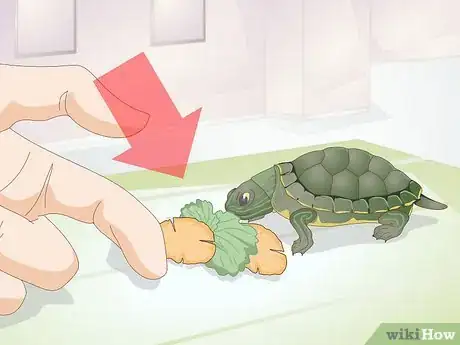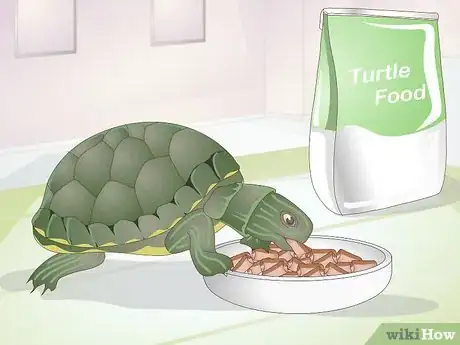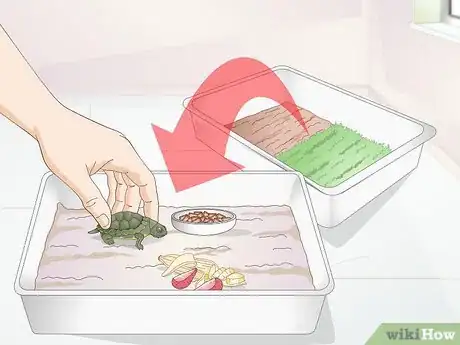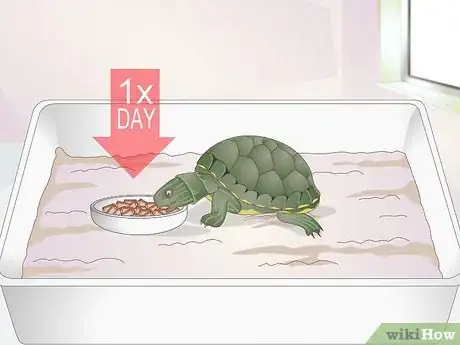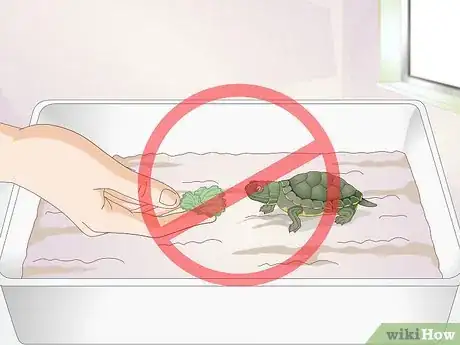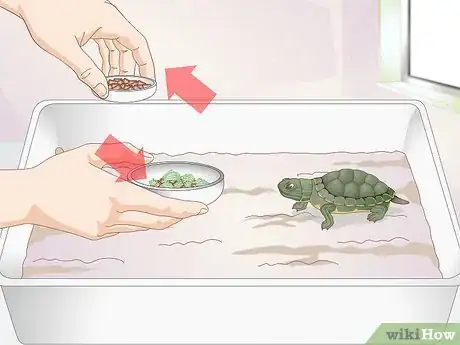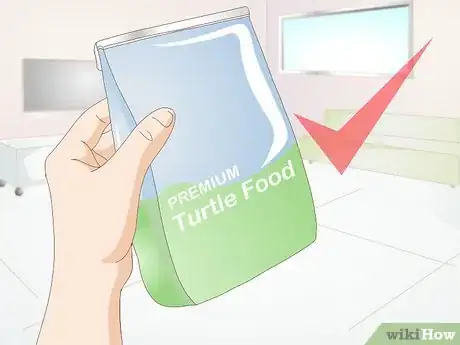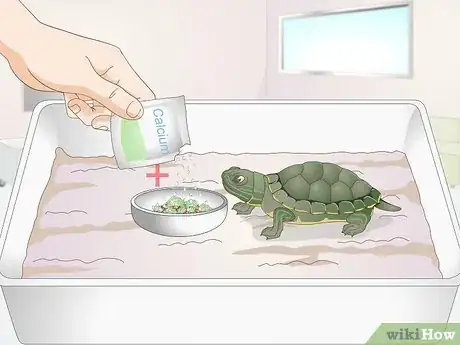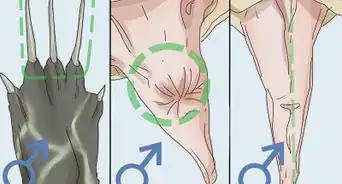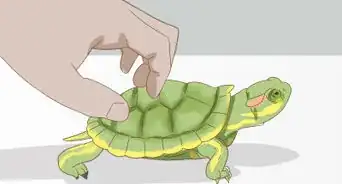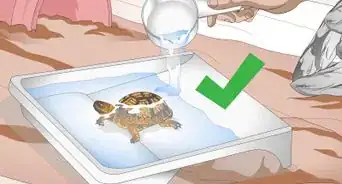This article was co-authored by Audra Barrios. Audra Barrios is a Marine Biologist and owner of Lick Your Eyeballs, a business offering experiemces, reptiles, supplies and plants. With over 15 years of experience, Audra specializes in reptiles and exotic animals, environmental education, marine biology, conservation issues, and animal husbandry. Audra earned a BASc in Marine Biology from the University of California, Santa Cruz, and studied Natural Sciences at the College of Marin. She is the founder and Executive Director of Things That Creep, a non-profit dedicated to herptile conservation through education. She has spent the last nine years working as a biologist at the California Academy of Sciences.
There are 11 references cited in this article, which can be found at the bottom of the page.
wikiHow marks an article as reader-approved once it receives enough positive feedback. This article received 14 testimonials and 80% of readers who voted found it helpful, earning it our reader-approved status.
This article has been viewed 255,475 times.
Infancy is a particularly important period for turtles. It is the time when they most need vitamins for growth and development. It is vital to establish that your baby turtle is fed in a comfortable, safe environment so that it will eat and get all of the nutrients it needs.
Steps
Gathering Supplies
-
1Know the eating habits of your turtle. Depending on the type of turtle, its eating habits will vary. Turtles are generally omnivorous, meaning their diet consists of both plants and animals, but some turtles' eating habits change over time.[1]
- Many types of turtles change their diet as they grow. A variety of breeds, such as red-eared sliders and green sea turtles, start off as mostly carnivores and transition to more plant-based diets as they mature.
- Other types of turtles remain strictly carnivores or strictly omnivores their whole life. Snapping turtles, for example, will always need a primarily carnivorous diet while loggerhead turtles will always need a combination of meat and plants.
- Figure out what kind of turtle you have. This may be quite obvious if, for example, you hatched the turtles yourself. If you bought it at a pet store, however, the species might not have been specified. Take your baby turtle to a vet with experience handling turtles to help with the identification process.
-
2Administer the food properly. A high-quality turtle pebble can be the base of a healthy diet. But other foods might also be options, depending on your turtle's specific needs. If so, be sure to expose your turtle to these other food sources. A diverse diet is important for turtles and their varied nutritional needs.
- Purina produces a type of turtle pellet through their Mazuri branch with different lines for specific types of turtle and their unique dietary needs. Rep-Cal also provides a range of pellet types catering to carnivores, herbivores, and omnivores. Other pellet brands include ReptoMin, ZooMed, Pretty Pets, and Wardley's Reptile Pellets. You can find pellets at pet stores or order them online.[2]
- If your turtle is a herbivore or omnivore, you should provide a variety of fruits and veggies in addition to pellets. Lettuce, kale, carrots, melon, and strawberries are all turtle friendly foods.[3] Consider aquatic plants that would be part of a turtle's regular diet, including duckweed, water lettuce, and water hyacinth.[4]
- If your turtle needs a meat-based diet, you can feed it mealworms, earthworms, crayfish, minnows, snails, slugs, and wax worms. These can be purchased at pet shops that sell turtles and other reptiles. Do not try to find worms yourself or go to a tackle shop for supplies. You want to verify that the worms are safe for turtle consumption.[5]
Advertisement -
3Create a food-friendly environment. Turtles need to feel comfortable to eat. In order to make sure your turtle will eat in its tank, create a food-friendly environment. To keep a clean home for your turtle you will typically want to feed it in a separate cage. This is not as imperative for baby turtles. Although it is not ideal, you might want to consider feeding a baby turtle in its regular cage if it will not eat otherwise. In that case, however, you will need to clean its tank more frequently.[6]
- Much like type of food, how you set food up in a cage is breed specific. Research how your turtle eats in their natural habitat and try to mimic this in the cage. For example, if your turtle is a carnivore it might prefer to catch prey itself, so releasing minnows in a small pool of water might be ideal.[7]
- Is your turtle a freshwater turtle or a land turtle? Freshwater turtles prefer to be submerged in water when they eat, so have a small pool of water in the tank where you feed it.[8] The depth of water should be very shallow for baby turtles to prevent drowning. Keep the depth under two inches.[9]
- If you are feeding your turtle insects, place the insects on land. If the insects make it into the water, they can increase the level of ammonia in the water. This would be bad for your turtle's skin and shell.[10]
- Fresh foods will spoil. Place all fresh food in a separate dish, so that it will not contaminate other food items. After fresh food has been out for several hours, throw it away.[11]
Feeding Your Turtle
-
1Decide how much to feed your turtle. How much and how often to feed baby turtles is contested by turtle owners and experts. However, it is generally recommended that baby turtles be fed often -- typically once a day -- because they are growing and need the extra vitamins and minerals.[12]
- Baby turtles should be fed every day. Afternoons and mornings are ideal feeding times; they are typically most active then and will be more likely to eat the food provided.[13]
- While people generally agree that babies should be fed each day, how much food they need is debated. Some people advise feeding babies as much as they will eat while others recommend limiting feeding times to a 15 to 20 minute time period. Talk to your vet about your turtle and ask her for advice on feeding.[14]
-
2Give the turtle food. Refrain from feeding your turtle by hand. If you do, it will associate food with your hands and might become inclined to bite.[15] When dealing with baby turtles, special considerations need to be taken in terms of preparing food.
- Turtle pellets should be broken into fourths as a baby turtle's mouth is smaller and you don't want it to choke.
- Any fruits bigger than a blueberry should be mashed or cut up to prevent choking.
- Vitamin and calcium supplements are sometimes recommended for young turtles to make sure they're getting adequate nutrition. If you opt to give your turtle supplements, you should do so about three times a week.[16]
-
3Deal with eating problems. Baby turtles are sometimes hesitant to eat, especially when first introduced to a tank. This is normal, but should be rectified. There are several approaches to deal with this sort of situation.
- Check the water temperature. Turtles will sometimes refrain from eating if the water is too cold or warm. Correct water temperature depends on breed, but generally it is approximately 84 degrees Fahrenheit.[17]
- Sometimes, movement can encourage eating. If your baby turtles are disinterested in pellets, live crickets or mealworms might stimulate their appetite.[18]
- If the problem persists for more than a few days, seek veterinary care to rule out any health problems.
Planning for the Future
-
1Transition to new food types and portions. Turtles can have a lengthy lifespan, meaning they are long-term pets. You need to be prepared to care for your turtle well past babyhood. Remember, food types and amounts change with age.
- Turtles are not considered adults until they are at least 7 years old. However, after three years their appetite should taper off naturally. When you notice your turtle eating less, it may be a sign that it is ready to transition to a new diet. Talk to your vet first, however, when you begin changing feeding frequency. You want to rule out any health problems and also get professional advice about food types and portions.[19]
- Adult turtles only need to be fed every other day, and some breeds only need food every third day. Adult turtles may have different dietary needs depending on breed. Determine whether you need to transition to a meat or plant based diet as your turtle ages.[20]
-
2Monitor your turtle's health. Changes in eating habits can signify health problems. If your turtle stops eating, keep an eye out for other common turtle problems.
- Watch for shell problems. A turtle's shell is an indicator of health and wellness. Changes to the shell can indicate poor nutrition, especially, though not exclusively, too little calcium in its diet. If you notice deformities, such as cone-shaped lumps or a flaky, rotting shell your turtle might not be getting the appropriate nutrition. Talk to your vet immediately.[21]
- Be on the watch for parasites. While rare, turtle food and pellets can be contaminated with certain parasites. Change in a turtle's appetite, energy, and weight might indicate a parasite.[22]
- Respiratory infections can be caused by a vitamin A deficiency. A runny nose or drooping eyelids can indicate a deficiency. Serious infections are marked by mouth-breathing, mucus in the mouth, or wheezing.[23]
-
3Make food decisions for long-term health. Your turtle could live for a very long time if cared for properly. Begin considering long-term health at an early age. Many health issues can be caused by an improper diet, so you should make decisions about feeding your turtle with an eye on its long-term well-being.
- Buy pellets from reputable companies and avoid off-brand, cheap pellets. Look into pellet reviews online and discuss with your vet to keep up-to-date on any recalls on turtle food.
- Make sure any produce you feed your turtle is fresh. Also, wash it before feeding your turtle. Remember, any pesticides or bacteria harmful to humans can also be harmful to your turtle. Prepare any produce that you feed your turtle as you would prepare it for yourself.
-
4Look into supplements. Because vitamin deficiencies are responsible for many turtle health problems, talk to your veterinarian about health supplements to ensure that your turtle is getting the nutrients it needs. Calcium is a particularly important nutrient for turtles. Calcium supplements for turtles can be purchased at a pet store. Dust calcium over the food up two or three times per week.[24]
Warnings
- Always wash your hands after handling your turtles as they may carry certain diseases harmful to humans.[25]⧼thumbs_response⧽
References
- ↑ Audra Barrios. Reptile Specialist. Expert Interview. 18 August 2020.
- ↑ http://www.austinsturtlepage.com/Care/care.htm
- ↑ http://www.austinsturtlepage.com/Care/care.htm
- ↑ http://www.reptilesmagazine.com/Care-Sheets/Turtles-Tortoises/Painted-Turtle/
- ↑ http://www.austinsturtlepage.com/Care/care.htm
- ↑ http://www.fishpondinfo.com/turtles/babycare.htm
- ↑ http://turtletanksetup.com/
- ↑ https://www.vetbabble.com/reptiles/turtles/
- ↑ http://www.fishpondinfo.com/turtles/babycare.htm
- ↑ http://pets.petsmart.com/guides/turtles/nutrition.shtml
- ↑ http://pets.petsmart.com/guides/turtles/nutrition.shtml
- ↑ http://pets.petsmart.com/guides/turtles/nutrition.shtml
- ↑ http://animals.mom.me/feed-pet-turtles-2299.html
- ↑ http://www.austinsturtlepage.com/Care/care.htm
- ↑ http://www.turtletails.net/raisingbabyturtles/tour10.htm
- ↑ http://animals.mom.me/feed-pet-turtles-2299.html
- ↑ http://animals.mom.me/feed-pet-turtles-2299.html
- ↑ http://animals.mom.me/feed-pet-turtles-2299.html
- ↑ http://animals.mom.me/feed-pet-turtles-2299.html
- ↑ http://animals.mom.me/feed-pet-turtles-2299.html
- ↑ http://www.hartz.com/Reptiles/Health_and_Nutrition/Health/Monitoring_Your_Turtles_Health.aspx
- ↑ http://www.hartz.com/Reptiles/Health_and_Nutrition/Health/Monitoring_Your_Turtles_Health.aspx
- ↑ http://www.hartz.com/Reptiles/Health_and_Nutrition/Health/Monitoring_Your_Turtles_Health.aspx
- ↑ http://pets.petsmart.com/guides/turtles/nutrition.shtml
- ↑ http://www.fda.gov/ForConsumers/ConsumerUpdates/ucm048151.htm
About This Article
To feed a baby turtle, start by figuring out what kind of turtle you have since different varieties of turtles prefer different foods. If your turtle is an herbivore, provide it with a variety of fruits and vegetables, as well as aquatic plants like duckweed and water lettuce. Alternatively, if your turtle is carnivorous, give it mealworms, earthworms, minnows, and slugs.Then, supplement your turtle's diet with high-quality turtle pellets made for your specific type of turtle. Additionally, make sure to feed your baby turtle daily to help it get all the nutrients it needs. For more tips from our Veterinarian reviewer, including how to create a positive feeding environment for your turtle, keep reading!
